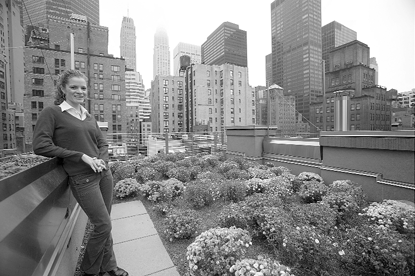By Daniel Wallace
Community arts center ABC No Rio is renovating its notoriously dilapidated four-story tenement building at 156 Rivington St. on the Lower East Side in the fashion of the Hanging Gardens of Babylon. Well, sort of.
“One aspect of the renovation is that we’re installing a green roof,” said Steven Englander, the director of ABC No Rio.
And while green roofs are not among the Seven Wonders of the World, they are in fact ancient technologies that resemble the stone terraces in Babylon’s Gardens, which were waterproofed with layers of reed, tar and tiles and which supported soil and vegetation. Green roofs — building tops covered with a layer of soil and foliage — are gaining popularity in modern urban settings.
“For the next generation of architects and designers, it’s almost inherent that if at all possible you install a green roof,” said Cameron Sinclair, executive director of Architecture for Humanity, an international nonprofit currently working on reconstruction projects in India, Sri Lanka and Pakistan, as well as several projects in New York, including ABC No Rio’s.
Sinclair said green roofs have an obvious aesthetic value amid the concrete expanse of a city. And they provide environmental benefits that are undeniable. Enough green roofs clustered together can reduce the urban heat island effect: cities are hotter than surrounding areas because of the heat-trapping properties of concrete and tall buildings. Green roofs can reduce air pollution by absorbing carbon dioxide and, acting both as insulator against the cold and shield against the sun’s radiation, they can lower energy costs of heating and cooling. Green roofs can also alleviate pressure on the city’s wastewater system by absorbing storm-water runoff.
“The role of the architect is to improve the environment of the community,” said Sinclair. “And if you’re not doing that, you’re doing the community a disservice. It’s not a question of why would you install a green roof. It’s why wouldn’t you?”
Well, for one thing, cost. According to Craig Tooman, an architect with the Manhattan-based firm Cutsogeorge, Tooman & Allen Architects, which has designed a green clubhouse building for the Lower East Side Girls Club, green roofs typically cost between $8 and $10 a square foot more than regular roofs. And the cost of maintenance for green roofs is obviously higher.
Sinclair said the cost of green roofs can be prohibitive for individual property owners. But with government support, in the form of incentives and grants, green roofs could be implemented on a citywide scale and could, potentially, provide an economic surplus, through reduced energy and wastewater costs.
“Look at Chicago,” Sinclair said. “It sounds crazy, but Mayor Daley is probably the most environmental mayor in America right now.”
Chicago’s Mayor Richard M. Daley installed the country’s first municipal green roof atop City Hall in 2001. And he has introduced requirements and incentives to prod private businesses to follow suit. The New York Times reported in August that there were approximately 2 million square feet of green roofs already built or in the process of construction in Chicago.
Although proponents of green roofs in New York City have been lobbying City Hall to offer incentives to developers and property owners, Sinclair said New York is still far behind Chicago — as well as behind many European and Asian cities — in adopting environmental technologies such as green roofs.
“Unfortunately, New York is lagging,” he said.
Englander said he is surprised more buildings haven’t implemented green roofs.
“They’re the easiest thing to do,” he said. “There’s a basic sort of grid, into which you put panels that hold the soil. And you don’t need that much soil.”
A green roof typically consists of an insulation layer, a waterproof membrane, a root barrier to prevent the roots of plants from penetrating the waterproof layer, a drainage layer, a filter mat, soil and, finally, vegetation.
There are two basic types of green roofs: intensive and extensive. Extensive roofs require soil depth that ranges from as little as 1 to 5 inches. Intensive roofs require deeper soil to provide root space for larger plants like trees and shrubs.
Despite a slow start, green roofs are catching on in New York. According to Leslie Hoffman, director of Earth Pledge, a Manhattan-based nonprofit organization that has built green roofs atop local buildings, there are probably as many as 50 green roofs in New York City.
“That’s a guess,” she said. “There could be more.”
Last summer a green roof was installed atop Silvercup Studios in Long Island City, Queens, where parts of the HBO series “The Sopranos” are filmed. Also in Long Island City, the Pratt Institute Center for Community and Environmental Development is installing a green roof atop the 11,000-square-foot Gratz Industries building, which will be the city’s first manufacturing building to install a green roof.
The Lower East Side Girls Club is constructing a three-building complex that will have two green roofs: one extensive and one intensive, where they’ll grow herbs for their cafe. And, of course, ABC No Rio’s roof is soon to blossom.
Despite signs of progress, some within the architectural community are frustrated with New York’s slow pace in adopting green roof technology.
“Maybe I’ll return to New York,” Sinclair said over the phone from Bozeman, Montana. “Once it’s been, you know, greened.”
google_ad_client = “pub-6226499064891091”;
google_ad_width = 468;
google_ad_height = 60;
google_ad_format = “468x60_as”;
google_ad_channel =”0606561524″;
google_color_border = “336699”;
google_color_bg = “FFFFFF”;
google_color_link = “0000FF”;
google_color_url = “008000”;
google_color_text = “000000”;
//–>
src=”https://pagead2.googlesyndication.com/pagead/show_ads.js”>
WWW Downtown Express































